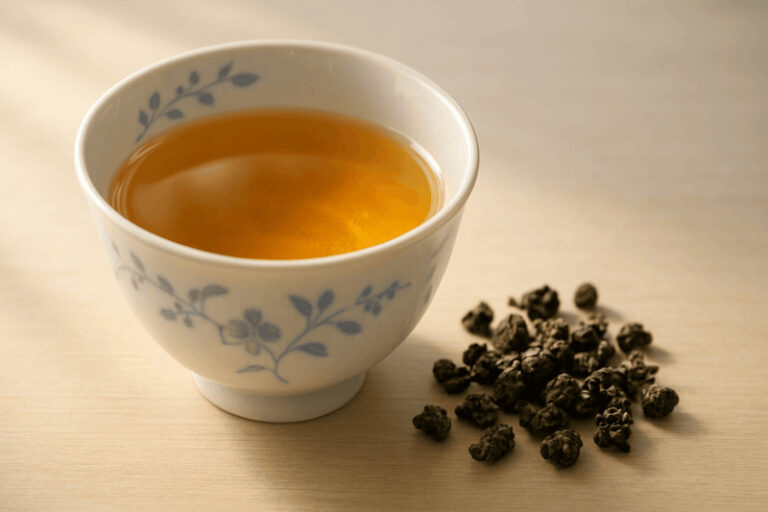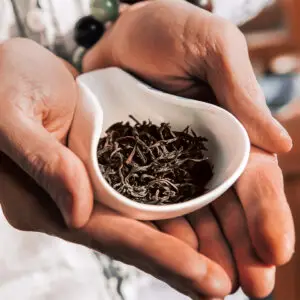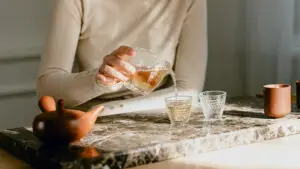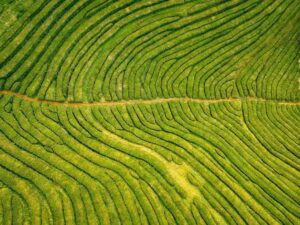Bridging the gap between the freshness of green tea and the depth of black tea lies the captivating world of Oolong. This partially oxidized tea, crafted from the leaves of the Camellia sinensis plant, offers a remarkable spectrum of flavors and aromas. Understanding what defines a high-quality Oolong involves appreciating the interplay of its cultivar, the unique terroir where it’s grown, and the meticulous skill of the tea master during processing.
When seeking exceptional Oolong, the appearance, aroma, and eventual taste of the brewed tea provide crucial clues. These characteristics are significantly shaped by two key processing stages: oxidation and roasting. The degree of oxidation, in particular, fundamentally transforms the tea’s profile, placing it uniquely between its green and black tea cousins.
Understanding Oolong Tea: Processing and Origins
The journey of an Oolong leaf begins similarly to other teas, starting with withering after harvest. However, Oolong production features a distinctive step: carefully controlled shaking or tumbling of the leaves. This bruising gently breaks down cell walls, initiating the crucial oxidation process. The tea master expertly manages environmental factors like sun exposure and humidity, alongside the duration and intensity of this oxidation, to cultivate the desired flavor profile.
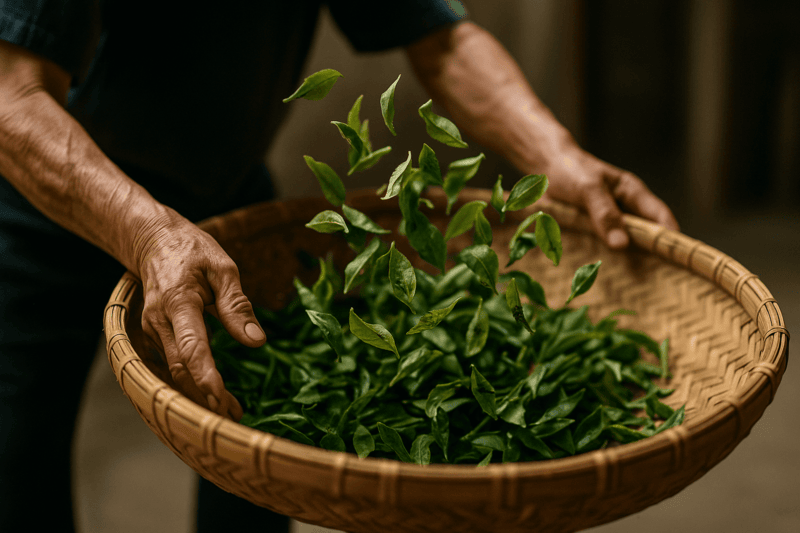
The level of oxidation dramatically influences Oolong’s character. Lighter Oolongs, with lower oxidation levels (sometimes generalized as 10-30%), often exhibit delicate floral and vegetal notes, reminiscent of green tea but with added complexity. Conversely, darker Oolongs undergo more extensive oxidation (potentially 40-70% or higher), developing richer, fruitier, or even roasted notes closer to black tea. Examples range widely, from the light, floral Jade Song Oolong of Taiwan to the fuller-bodied, amber-hued Oolongs from regions like Wuyi in China.
Following oxidation, the leaves are typically rolled or shaped – sometimes into tightly compressed balls common in Taiwan, which helps preserve freshness – and then dried or fired to halt oxidation and reduce moisture content. This final drying stage, often involving roasting, further refines the tea’s aroma and taste.
Historically, Oolong tea production is most renowned in Fujian province (including the Wuyi Mountains and Anxi county) in Mainland China, and across the island of Taiwan. These regions remain the primary sources for many of the world’s most celebrated Oolongs. Regarding caffeine, Oolong tea’s content varies considerably depending on the specific cultivar, growing conditions, leaf age, and processing methods. While it generally falls between green and black teas, typical values can range widely, often cited between 10 to 60 milligrams per 8oz (240ml) cup – significantly less than standard drip coffee. Furthermore, the caffeine extracted decreases with each subsequent infusion. High-quality Oolongs are prized for their ability to yield multiple infusions (sometimes up to 6 or more), with each steeping revealing evolving nuances of flavor and aroma.
The Spectrum of Oxidation in Oolong Tea
Oolong tea’s defining characteristic is its vast diversity, largely attributable to the wide range of oxidation levels employed during processing. This spectrum creates profiles ranging from light and green-like to dark and robust. For instance, a Wenshan Pouchong might be lightly oxidized (around 10–25%), preserving bright, floral qualities, while a traditional Da Hong Pao (Big Red Robe) from the Wuyi Mountains could be significantly more oxidized (perhaps 50%–70%).
The oxidation journey begins soon after picking and can involve numerous intricate steps over hours or even days. Tea artisans often gently toss or tumble the leaves, traditionally in bamboo baskets, to encourage even bruising and airflow, thereby managing the oxidation process. This crucial phase is halted by applying heat (pan-firing or roasting), a step requiring considerable expertise to lock in the desired aromatic compounds without damaging the leaf.
Lightly oxidized Oolongs, particularly those from Taiwan, are often celebrated for their vibrant floral notes, inherent sweetness, and creamy mouthfeel. Their infusions tend to be pale greenish-gold, offering a smooth, mellow taste, sometimes with a lingering, subtly crisp finish.
Darker Oolongs, such as the famous Wuyi “rock teas” (Yancha), offer a contrasting experience. Grown in the mineral-rich, rocky terrain of the Wuyi Mountains, these teas often exhibit a unique “minerality” (sometimes described as ‘Yan Yun’ or rock rhyme) alongside roasted, nutty, or fruity notes. Their infusions are typically a deeper amber or reddish-brown, presenting a full-bodied, sometimes surprisingly complex brew that can appeal even to coffee drinkers.
Beyond these examples primarily defined by their position on the light-to-dark oxidation scale, other Oolongs showcase unique characteristics developed through specific processing choices within this spectrum. Notably, Phoenix Dancong (Phoenix Single Bush) Oolongs from Guangdong province represent another fascinating facet of Oolong diversity. While their oxidation levels can vary (often falling in the medium to higher range), they are most famous for their extraordinary aromatic complexity, meticulously crafted to mimic specific flower or fruit scents like orchid, gardenia, almond, or honey. This incredible range of fragrances is a testament to the precise control tea masters exert over the oxidation and subsequent processing steps, tailored to highlight the unique potential of leaves often harvested from older, single trees.
While factors like season and weather can influence the exact oxidation outcome across all Oolong types, the tea master’s skill in adapting the process remains paramount in achieving the intended flavor and aromatic profile, contributing to the rich tapestry of Oolong varieties available.
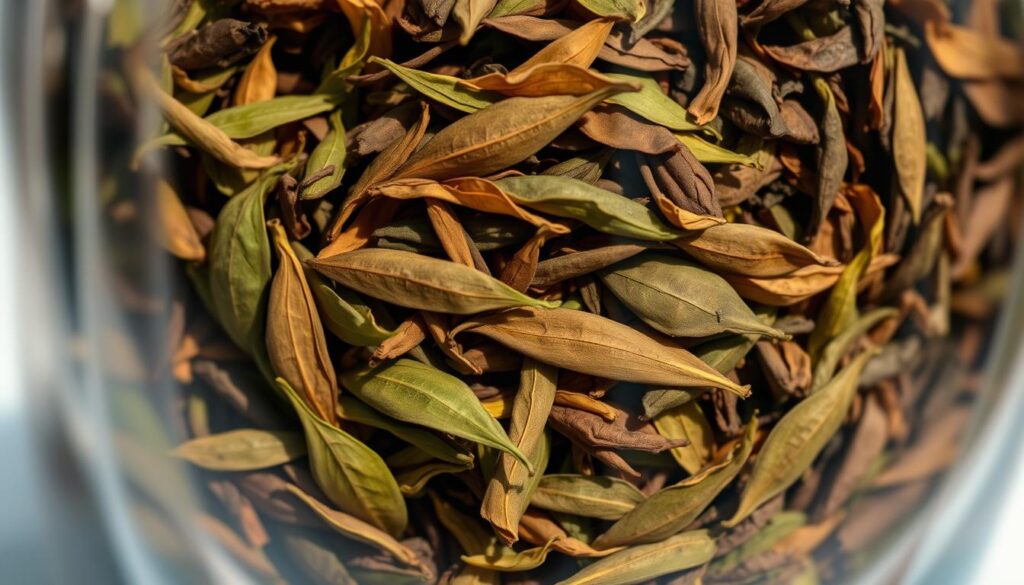
Roasting: Refining Oolong’s Flavor and Aroma
Beyond oxidation, roasting is a critical technique for shaping the final character of many Oolong teas. Tea masters carefully consider factors like the tea’s origin, cultivar, and oxidation level when determining the appropriate roasting intensity and duration. This process doesn’t just dry the tea; it transforms precursors developed during oxidation into new aromatic compounds, adding layers of depth and complexity.
The level of roast significantly impacts the sensory profile:
- Light Roasting: Often preserves or enhances delicate floral aromas. The resulting brew is typically lighter in color (pale yellow to gold).
- Medium Roasting: Can develop fruitier notes (like baked fruit or stone fruit) and a richer mouthfeel. The infusion color deepens towards golden amber.
- Heavy Roasting: Creates distinct nutty, caramel, or even chocolatey notes, reducing astringency and resulting in a darker, reddish-brown infusion.
Artisans employ various roasting methods, from traditional charcoal roasting over embers to modern electric ovens, carefully controlling temperature and time. For instance, achieving certain sweet, baked notes might involve multiple roasting sessions at specific temperatures (e.g., initial roast at 80-85°C, followed by a lower temperature roast). Maintaining precise heat is crucial to develop desirable aromas without scorching the leaves or losing volatile compounds.
Different tea cultivars also respond differently to heat. Thicker leaves, like those used for Tieguanyin or some large-leaf varieties, might tolerate higher roasting temperatures than more delicate leaf types. The tea master’s expertise in tailoring the roast profile to each specific batch is essential for crafting exceptional Oolong tea.
Characteristics of High-Quality Oolong
Evaluating Oolong tea quality involves assessing several key attributes: the appearance of the dry leaf, its aroma, the color and clarity of the infusion, its taste and mouthfeel, and the quality of the spent leaves.
- Dry Leaf Appearance: High-quality Oolong leaves should exhibit reasonable uniformity in size, shape (whether tightly rolled balls or twisted strips), and color. This indicates careful harvesting (often hand-plucking) and meticulous sorting. Depending on the type, the color might range from deep green with lighter highlights (for greener Oolongs) to darker brown or black with reddish or coppery tones (for more oxidized or heavily roasted types). Consistently yellow or dull leaves might suggest late harvesting or improper processing.
- Aroma: The dry leaf aroma should be clean, pleasant, and indicative of the tea type (e.g., floral, fruity, roasted). Upon opening a well-sealed package, a fresh, inviting fragrance is a good sign. Strong stale, sour, or overly ‘green’ (like raw vegetation) odors can indicate poor quality or storage. Sensory studies often identify “flowery” and “fruity” as common desirable aroma descriptors for Oolongs.
- Infusion Color: The brewed tea’s color should be clear and bright, ranging from pale “honey yellow” for light Oolongs to deeper “orange-red” or amber for darker varieties, reflecting the oxidation and roast levels. Cloudiness can sometimes suggest lower quality or issues with processing.
- Taste and Mouthfeel: Exceptional Oolong offers a complex and evolving taste profile. It should feel smooth, often described as having a pleasant texture or “mouthfeel.” A defining feature is often the huigan, a returning sweetness or cooling sensation in the throat after swallowing. While subtle bitterness or astringency can contribute to structure and complexity (terms like “astringent” and “bitterness” appear in sensory analyses), harsh, overwhelming, or metallic bitterness/astringency is typically considered a flaw, possibly resulting from poor processing or incorrect brewing.
- Brewing: While general guidelines suggest brewing temperatures between 185°F and 205°F (85°C and 96°C) and steeping times from 1 to 3 minutes, optimal parameters vary significantly based on the specific Oolong type and personal preference. Lighter, greener Oolongs often benefit from slightly cooler water and shorter initial infusions, while darker, rolled Oolongs might require hotter water and slightly longer times, especially for later infusions. Experimentation is key.
Famous Oolong Tea Varieties: A Glimpse into Diversity
Originating during China’s Ming and Qing dynasties, Oolong tea boasts a rich history and numerous celebrated varieties. Here are a few notable examples, grouped by origin:
Mainland China:
- Wuyi Rock Teas (Yancha)
Grown in the Wuyi Mountains of Fujian province, these teas are famous for their characteristic “minerality” or ‘rock rhyme’ derived from the unique terroir.
- Da Hong Pao (Big Red Robe): Perhaps the most famous Yancha, known for its complex roasted notes and long finish.
- Tie Luo Han (Iron Arhat): Another highly regarded Wuyi rock tea, often exhibiting rich, warming flavors.
- Shui Xian (Water Sprite/Narcissus): Often yields a smoother profile with notes of honey or florals alongside the mineral base.
- Anxi Oolongs
From Anxi county in Fujian, known for more floral and sometimes greener styles. - Guangdong Oolongs – Phoenix Dancong (Phoenix Single Bush)
From the Phoenix Mountains, renowned for its incredible aromatic diversity, mimicking specific fruit or flower scents (e.g., honey orchid, almond, gardenia). Leaves are typically large and twisted.
Taiwan:
- High Mountain (Gao Shan) Oolongs: Grown at high elevations (often above 1,000 meters), benefiting from cool temperatures and misty conditions, which develop complex aromatics.
- Alishan: Known for creamy textures and floral, sometimes milky notes.
- Lishan: From even higher elevations, often prized for elegance, clarity, and nuanced fruit/floral notes.
- Shan Lin Xi: Often displays refreshing vegetal and floral notes with a smooth finish.
- Dong Ding (Frozen Summit): A traditional Taiwanese Oolong, typically medium-oxidized and roasted, offering a balance of floral notes and a comforting roasted character. Considered one of Taiwan’s classic teas.
- Jin Xuan (Golden Lily / Milk Oolong): A specific cultivar known for its naturally creamy mouthfeel and light milky aroma, often lightly oxidized.
- Oriental Beauty (Dongfang Meiren / Bai Hao): A unique, heavily oxidized Oolong, famous for its honey-sweetness resulting from insect bites (leafhoppers) on the growing leaves, triggering unique defensive compounds.
This list merely scratches the surface, highlighting the vast regional and stylistic diversity within the Oolong category.
Conclusion
Oolong tea represents a fascinating and diverse category within the world of tea, offering an expansive range of flavors and aromas shaped primarily by varying levels of oxidation and diverse roasting techniques. From the bright, floral notes of a lightly oxidized Taiwanese High Mountain Oolong to the deep, mineral complexity of a Phoenix Oolong tea, there is an Oolong to suit nearly every palate.
Understanding the key factors influencing quality – careful cultivation, meticulous processing involving controlled oxidation and roasting, and the resulting characteristics in leaf appearance, aroma, and taste – allows tea enthusiasts to navigate this category with greater appreciation. Exploring famous varieties from core regions like Fujian, Guangdong, and Taiwan reveals the rich cultural heritage and craftsmanship embedded in Oolong production.
Experimenting with brewing parameters further unlocks the unique potential of each Oolong, often revealing evolving nuances over multiple infusions. While the journey into Oolong can seem complex, it is ultimately a rewarding exploration of flavor, aroma, and texture, inviting a deeper appreciation for this captivating and sophisticated tea.
